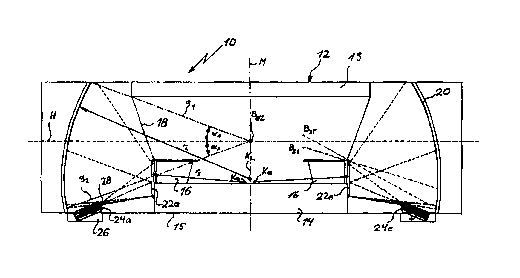Some of the information on this Web page has been provided by external sources. The Government of Canada is not responsible for the accuracy, reliability or currency of the information supplied by external sources. Users wishing to rely upon this information should consult directly with the source of the information. Content provided by external sources is not subject to official languages, privacy and accessibility requirements.
Any discrepancies in the text and image of the Claims and Abstract are due to differing posting times. Text of the Claims and Abstract are posted:
| (12) Patent Application: | (11) CA 2325495 |
|---|---|
| (54) English Title: | METHOD AND DEVICE FOR WIDE-ANGLE PROJECTION |
| (54) French Title: | PROCEDE ET DISPOSITIF POUR PROJECTION GRAND ANGLE |
| Status: | Deemed Abandoned and Beyond the Period of Reinstatement - Pending Response to Notice of Disregarded Communication |
| (51) International Patent Classification (IPC): |
|
|---|---|
| (72) Inventors : |
|
| (73) Owners : |
|
| (71) Applicants : |
|
| (74) Agent: | OSLER, HOSKIN & HARCOURT LLP |
| (74) Associate agent: | |
| (45) Issued: | |
| (86) PCT Filing Date: | 1999-02-11 |
| (87) Open to Public Inspection: | 1999-08-19 |
| Availability of licence: | N/A |
| Dedicated to the Public: | N/A |
| (25) Language of filing: | English |
| Patent Cooperation Treaty (PCT): | Yes |
|---|---|
| (86) PCT Filing Number: | PCT/EP1999/000897 |
| (87) International Publication Number: | WO 1999041641 |
| (85) National Entry: | 2000-09-22 |
| (30) Application Priority Data: | ||||||
|---|---|---|---|---|---|---|
|
The invention relates to a method for highly accurate wide-angle projection,
according to which a light cone emanating from a projector is diverted by a
convex, spherical mirror onto an essentially concave screen. The method is
carried out by means of a device for wide-angle projection, comprising at
least one projector (24), in front of whose lens (28) a mirror (22) with a
spherically convex mirror surface (32) is arranged. The mirror surface (32)
faces an essentially spherically concave screen (20).
L'invention concerne un procédé selon lequel, pour permettre une projection grand angle très précise, un cône lumineux sortant d'un projecteur est dévié, par un miroir sphérique convexe, sur un écran sensiblement concave. Ce procédé est mis en oeuvre avec un dispositif pour projection grand angle qui comporte au moins un projecteur (24) devant l'objectif (28) duquel est placé un miroir (22) comportant une surface réfléchissante (32) sphérique, convexe qui fait face à un écran (20) sensiblement sphérique, concave.
Note: Claims are shown in the official language in which they were submitted.
Note: Descriptions are shown in the official language in which they were submitted.

2024-08-01:As part of the Next Generation Patents (NGP) transition, the Canadian Patents Database (CPD) now contains a more detailed Event History, which replicates the Event Log of our new back-office solution.
Please note that "Inactive:" events refers to events no longer in use in our new back-office solution.
For a clearer understanding of the status of the application/patent presented on this page, the site Disclaimer , as well as the definitions for Patent , Event History , Maintenance Fee and Payment History should be consulted.
| Description | Date |
|---|---|
| Inactive: Agents merged | 2013-10-29 |
| Inactive: IPC from MCD | 2006-03-12 |
| Inactive: IPC from MCD | 2006-03-12 |
| Application Not Reinstated by Deadline | 2004-02-11 |
| Time Limit for Reversal Expired | 2004-02-11 |
| Deemed Abandoned - Failure to Respond to Maintenance Fee Notice | 2003-02-11 |
| Letter Sent | 2001-02-02 |
| Inactive: Single transfer | 2001-01-11 |
| Inactive: Cover page published | 2000-12-29 |
| Inactive: First IPC assigned | 2000-12-21 |
| Inactive: Courtesy letter - Evidence | 2000-12-19 |
| Inactive: Notice - National entry - No RFE | 2000-12-18 |
| Application Received - PCT | 2000-12-16 |
| Application Published (Open to Public Inspection) | 1999-08-19 |
| Abandonment Date | Reason | Reinstatement Date |
|---|---|---|
| 2003-02-11 |
The last payment was received on 2002-01-31
Note : If the full payment has not been received on or before the date indicated, a further fee may be required which may be one of the following
Please refer to the CIPO Patent Fees web page to see all current fee amounts.
| Fee Type | Anniversary Year | Due Date | Paid Date |
|---|---|---|---|
| Basic national fee - small | 2000-09-22 | ||
| Reinstatement (national entry) | 2000-09-22 | ||
| Registration of a document | 2001-01-11 | ||
| MF (application, 2nd anniv.) - small | 02 | 2001-02-12 | 2001-02-08 |
| MF (application, 3rd anniv.) - small | 03 | 2002-02-11 | 2002-01-31 |
Note: Records showing the ownership history in alphabetical order.
| Current Owners on Record |
|---|
| DATAFRAME VERTRIEB AUDIOVISUELLER KOMMUNIKATIONSSYSTEME GMBH |
| Past Owners on Record |
|---|
| PETER MAYR |